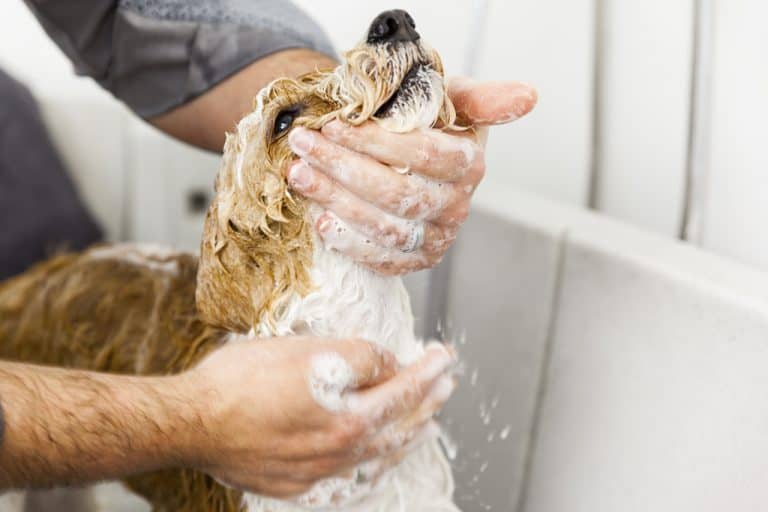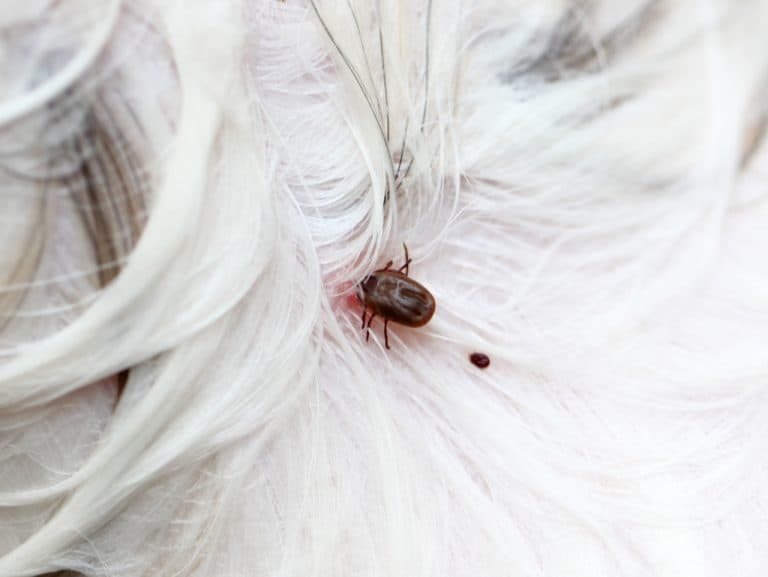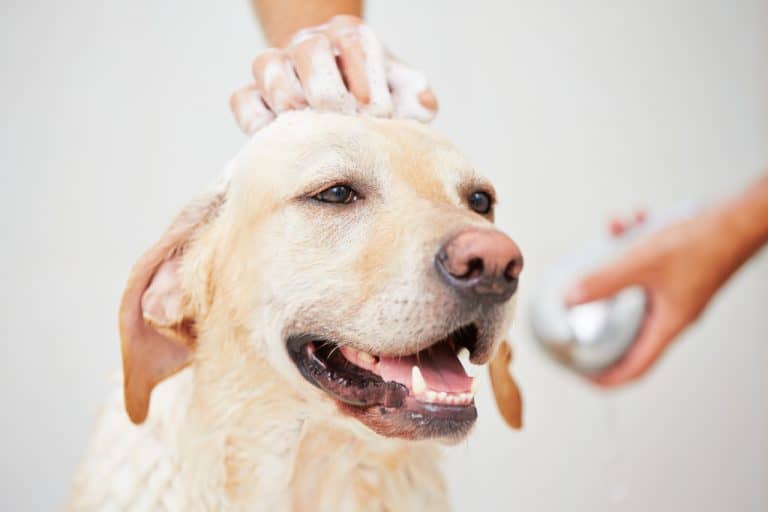As you may have already known, fleas and ticks can cause many problems for dogs.
These disgusting parasites may carry diseases that can be transmitted to your pooch while feeding on your dog’s blood.
Not to mention, they also pose a threat to humans!
Fortunately, with the help of the best dog flea collar, it can effectively kill, repel, and prevent a flea and tick infestation.
One thing to note, though, dog flea collars and cat flea collars aren’t the same. And they are not interchangeable.
In this article, you will find our top 5 picks for the best preventative collars for dogs. Understand why you should be using one and what to look for when purchasing. Learn the differences between dog and cat flea collars and why they aren’t interchangeable, and we’ve also listed other things you can do to prevent an infestation.
Without further ado, let’s take a look at the 5 top-rated flea collars for dogs that can keep disease-carrying little buggers at bay!
| Editor's Choice | Product | Protection Period | Active Ingredients |
|---|---|---|---|
| Our Top Pick | Bayer Seresto Flea Collar for Dogs | 8 months | Chemical |
| Best Hypoallergenic | SOBAKEN Flea and Tick Prevention for Dogs | 8 months | Natural |
| Best for Puppies | Arava Flea & Tick Prevention Collar | 6 months | Natural |
| Best Fast-Acting | Rolf Club 3D Flea Collar for Dogs | 6 months | Chemical |
| Best for Budget | Primova Flea and Tick Collar for Dogs | 8 months | Natural |
Read More:
- Why Use a Flea Collar On My Dog?
- Understanding the Differences Between Dog Flea Collars and Cat Flea Collars
- How Do I Know if My Canine Has Dog Fleas?
- Are Fleas and Ticks the Same?
- How Did My Canine Get Fleas?
- Best Dog Flea Collars Buyer’s Guide: What to Look For
- Other Things that You Can Do to Prevent a Flea Infestation On Your Dog
- Frequently Asked Question About the Dog Flea Collar
1. Our Top Pick - Bayer Seresto Flea Collar for Dogs
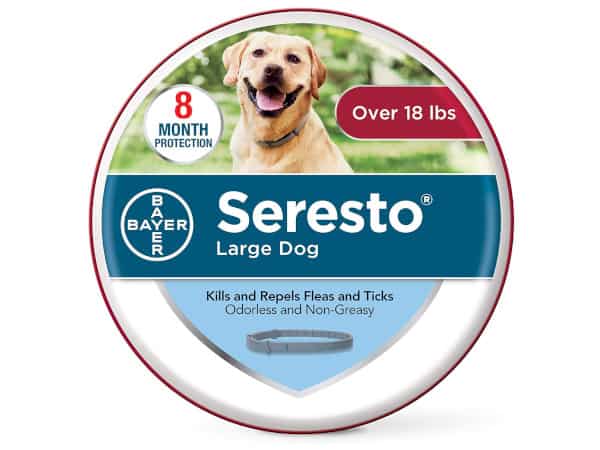
The Seresto Flea Collar is one of the best flea collars on the market, designed to kill and repel pesky fleas and ticks, ultimately protecting your furry friend from unwanted pain and diseases.
It is a veterinarian-recommended collar that is odorless and non-greasy, which won’t make it uncomfortable for your dog to wear. With its sustained release technology, it will provide continuous protection over your dog’s body, coat, and skin for eight months, meaning there is no need for messy monthly treatments anymore!
This collar can kill fleas and ticks through close contact without having to wait for the pests to bite your dog. Not to mention, it is water-resistant and will maintain its efficacy after swimming or exposed to rain and sunlight, making it an ideal option for all-year-round use.
Though Seresto collars use imidacloprid and flumethrin, they are generally safe as they contain appropriate dosages. That said, make sure to consult with your veterinarian first if your dog is pregnant or nursing before using this product.
Features:
- 8-month prevention and treatment of fleas and ticks
- Sustained release technology
- Non-greasy
- Odorless
- Water-resistant
- Two sizes available (for small dogs of up to 18 pounds and large dogs over 18 pounds)
- You don’t have to wait for fleas to bite your dog
- It can also help treat and control sarcoptic mange and kill lice
- Relatively safe pesticide combination
- Recommended by veterinarians
- Made by a health giant, Bayer
- Most dog owners are pleased with its effectiveness
- It is a bit pricey
2. Best Hypoallergenic - SOBAKEN Flea and Tick Prevention for Dogs
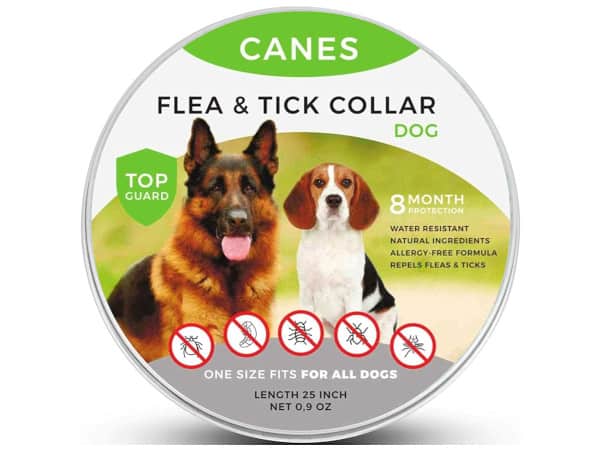
Worry about flea collars with chemicals may cause unwanted side effects like nausea, loss of appetite, and vomiting? Then, you may want to consider the SOBAKEN Flea and Tick Prevention for Dogs.
It uses a 100% non-toxic formula and contains natural ingredients such as spearmint oil, clove oil, and citronella essential oil. It will continuously release and distribute the active ingredients over your dog’s coat and skin to keep them safe and protected from fleas, ticks, flea larvae, chewing lice, and scabies for eight months.
We also like that it is hypoallergenic, making it an excellent option for dogs prone to allergies. This vet-recommended flea collar is also waterproof and will continue to be 100% effective after bathing or playing in the water.
Features:
- Eight months protection
- Natural ingredients
- Hypoallergenic formula
- Waterproof
- Suitable for puppies over three months of age
- Great for dogs who tend to have skin sensitivities
- It doesn’t contain any chemicals
- Vet-recommended
- This brand supports animal-focused organizations, in which they donate $3 with every collar sold
- Some owners noted that the smell is a bit overpowering
3. Best for Puppies - Arava Flea & Tick Prevention Collar
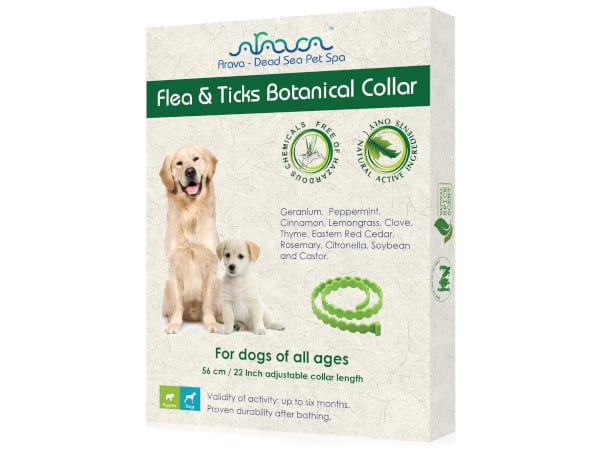
The Arava Flea & Tick Prevention Collar is another 100% natural flea and tick collar, free of hazardous chemical insecticides to ensure your four-legged friend is safe while preventing an irritating flea and tick infestation.
It uses a patented Micro-Injection Technology to infuse the essential oils into the collar and utilize the Slow-Release process to emit the active ingredients through the plastic’s special pores. That will then be distributed over your dog’s fur and skin, offering six months of protection.
This all-natural flea and tick preventative is waterproof and rainproof, made with eleven active botanical ingredients that can repel nearly five hundred different insect species. The ingredients used are not only safe for your dog but also for you and your kids.
Features:
- Last up to six months
- Eleven natural active ingredients
- Natural scent
- Waterproof
- MSDS tested and FDA certified
- Suitable for adult dogs and puppies of all ages
- 100% natural and contains no chemical pesticides
- Infused with natural essential oils used in aromatherapy to add an extra layer of security to prevent an itchy flea bite
- It can repel nearly five hundred species of insects
- Safe around children
- It has a strong and overwhelming scent upon opening the bag for the first few days
- This collar is for repelling fleas and ticks only, not killing
4. Best Fast-Acting - Rolf Club 3D Flea Collar for Dogs
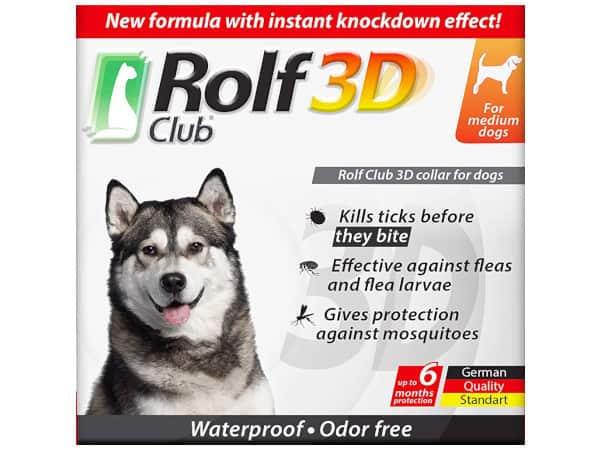
When you see your dog itching and scratching, you surely would want to get a collar that can act quickly to help relieve your fido’s discomfort. With the Rolf Club 3D Flea Collar, it can achieve that, designed to kill fleas within the first 24 to 48 hours of application.
It features a new German technology that can combat fleas, flea larvae, ticks, and mosquitoes for six months. Also, it can kill fleas before they have the chance to bite your pooch. Plus, it is odorless and waterproof, meaning you don’t have to worry that the treatment effectiveness will be affected if it is wet and dirty.
This flea and tick repellent is a one-size-fits-all collar that suits small, medium, and large dogs, meaning you don’t need to measure your dog’s neck circumference. They will ship you a really long collar, and all you need to do is to place it around your canine’s neck, adjust the fit, buckle in place, then cut off and dispose of excess length.
Features:
- New German formula
- Last up to six months
- Odor-free
- Waterproof
- One size fits all
- Quick effect, which will start working within the first 24 to 48 hours after the start of use
- It can eradicate pesky fleas and ticks before they bite
- This flea prevention collar also offers protection against mosquitoes
- It has multiple loops where you can feed the collar through to make sure it won’t easily fall off
- Many owners are impressed and noted that it is especially effective against fleas and flea larvae
- The strap is a bit weaker than other brands
5. Best for Budget - Primova Flea and Tick Collar for Dogs
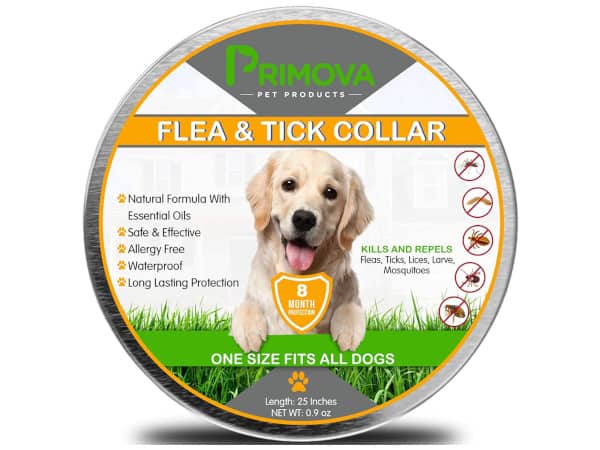
Are you on a budget and seeking an all-natural flea collar with a relatively low price tag? Check out the Primova Flea and Tick Collar for Dogs.
It is available at an affordable price, contains natural essential oils, no harmful chemicals, and can kill and repel fleas, flea eggs, ticks, lice, mosquitoes, and more than five hundred different species of insects. Plus, it uses an allergy-free formula to ensure it is tolerable for all dogs, even those with sensitive skin.
Additionally, this dog flea collar is waterproof, which will still work after swims or weekly baths, combined with a reinforced buckle to prevent it from falling off during rough play. What’s more, it includes a 30-day risk-free money-back guarantee!
Features:
- Eight months protection
- Natural formula with essential oils
- Allergy-free
- Non-greasy
- Waterproof
- One size fits all dogs
- Include a flea comb
- Affordable
- Chemical-free
- It can kill and repel a whole range of parasites, including fleas, ticks, and mosquitoes
- It comes with a free flea comb
- Backed by a 30-day risk-free money-back guarantee
- Less effective compared to other brands
- It has a citrus scent, which some dogs may not like
Why Use a Flea Collar On My Dog?
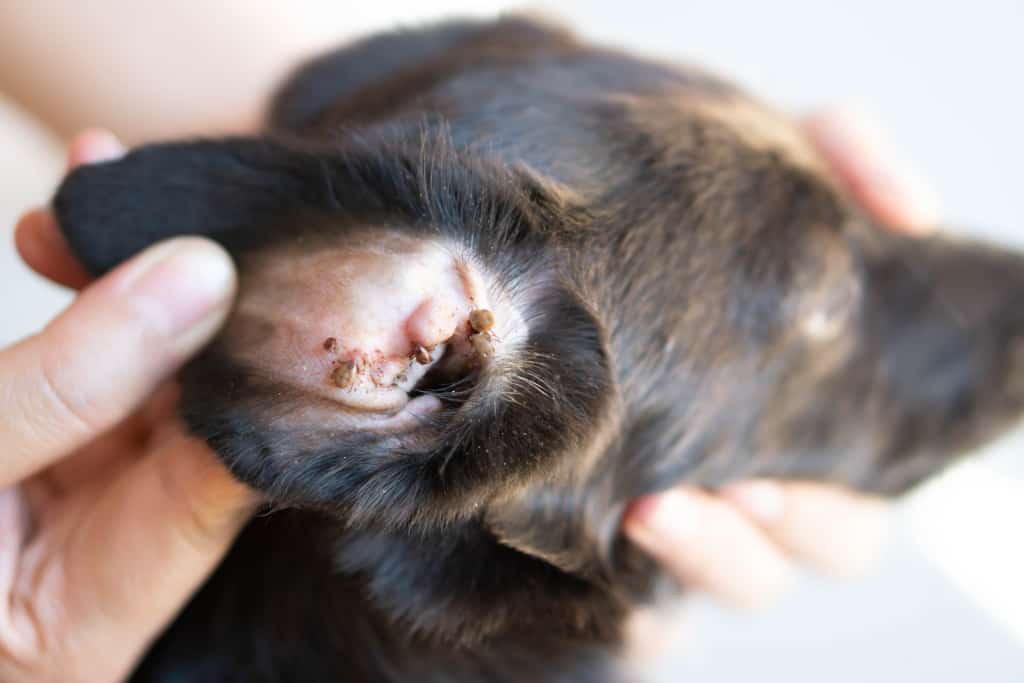
Dog fleas, also known as Ctenocephalides canis (Curtis), are ectoparasites that can cause many problems in canines. Their bites can cause excessive itching, which will lead to open sores and will, in turn, make your pup vulnerable to infection. Since fleas feed on the blood of the host animal, a flea infestation can potentially cause anemia. It is a condition in which a dog loses too much blood and can be fatal in severe cases.
Not to mention, some dogs have allergic reactions to flea saliva, also known as dog flea allergy or flea dermatitis. They will suffer from hair loss, and their skin will turn red, begin to swell, develop sores and scabs, and become uncomfortably itchy, especially the base of their tail. Plus, fleas can carry tapeworms, which can cause weight loss, debilitation, and nutritional deficiency in your canine if ingested. That’s why you will need a dog flea collar!
A flea collar or neckband for dogs is one of the most effective preventative tools in fighting and destroying flea’s life cycle (egg, larva, pupa, and adult), which is especially needed if your pup loves to spend most of the time outdoors.
These collars or neckbands are typically made of plastic and contain an active ingredient (natural or chemical), depending on which brand you choose. They work by either releasing toxic gases to parasites to repel and keep fleas from approaching your pooch or spreading insecticide through the natural oils of your canine’s coat and skin to kill pests on contact.
These critter preventatives are inexpensive, highly effective, and convenient, in which you can easily buy one and put it on your dog, and that will last for up to three or eight months, depending on which one you buy. They are also great for dogs who hate taking medications or don’t react well to spot-on flea and tick treatment.
Understanding the Differences Between Dog Flea Collars and Cat Flea Collars
While flea collars for dogs are useful in protecting your fido against pesky parasites, it is important to note that they are not the same as cat flea collars and should not be used interchangeably. The reason is that they contain different insecticides and amounts of chemicals, and dog flea collars should be more potent than cat flea collars.
Using a dog flea collar on cats can make them sick as they don’t have the ability to process, break down, and absorb the chemicals as quickly as dogs, and in severe cases, it can lead to death. So, always read the label of the product carefully. Make sure the collar you are getting is specially formulated for the specific species before your purchase.
How Do I Know if My Canine Has Dog Fleas?
You know your dog has fleas when you see them scratch and itch a lot more than usual. Finding red bumps on their groin, belly, under their legs, at the base of their tail, or seeing flea excrement or feces, also known as flea dirt, which looks like small brown-black specks, when running a flea comb through your dog’s fur could also be a sign that fleas were recently present or still present on your pup.
Are Fleas and Ticks the Same ?
Although fleas and ticks share many similarities, they are not the same. Fleas are wingless, have six legs, and can jump. Ticks, on the other hand, have six to eight legs and are arachnids. Meaning they are related to spiders. Fleas can carry tapeworms, cause skin issues, flea dermatitis, and anemia. In contrast, ticks can spread potentially deadly diseases, like Lyme disease and Rocky Mountain spotted fever, which is far more dangerous. So if you happen to also find a tick on your pup, make sure to extract it as soon as you can with tools specially designed to remove ticks.
How Did My Canine Get Fleas?
Ever wonder how your fido gets fleas in the first place? Read on to find out!
From Other Animals
One of the many common ways your pup will pick up fleas is from other pets or feral animals, including rodents, birds, squirrels, foxes, and deer. Fleas can easily jump from the carriers onto your pup for their first blood meal and start a colony.
From Dog Parks
Your four-legged friend can also contract fleas from dog parks. These places usually have fleas creeping around, especially during flea season (the warmer months of the year), and the annoying hitchhikers will either jump directly from the ground to your dog or from dog to dog.
From Pet Facilities
Another common culprit is pet facilities, including boarding kennels, doggy daycare, and grooming facilities. While these facilities usually have strict rules to prevent fleas, an infestation can still occur as the flea treatment used varies from dog owner to dog owner.
Best Dog Flea Collars Buyers’ Guide : What to Look For
Before you make your final decision, below are what you should be considering to ensure you pick the one that best suits your furry best friend.
1. All-Natural vs. Chemical
There are two types of flea prevention collars for dogs you can find on the market, all-natural and chemical. So, which one is better?
- All-Natural.
The benefit of using all-natural dog flea collars such as the SOBAKEN Collar, Arava Collar, and Primova Collar is that they are safer for dogs than those infused with chemical ingredients. However, you will expect them to be less effective. - Chemical.
Chemical flea collars, on the other hand, are much more powerful and effective. Not only can they ward off annoying parasites, but they can also sterilize eggs and larvae and kill pests through close contact. Some examples include the Seresto Collar and Rolf Club 3D Flea Collar. The only drawback of chemical flea collars is that they may cause side effects such as skin irritation, diarrhea, vomiting, or other more severe reactions.
2. Protection Duration
The protection period varies from product to product. Picking the ones with extended protection periods means less hassle for you. You would also want to mark when the protection ends on your calendar, and it’s a good idea to set a reminder two weeks before that day so that you have enough time to buy another best flea collar for your dog to keep them protected.
3. Waterproof or Water-Resistant
Imagine you just bought a non-water-resistant flea collar, put it on your dog, and they jump straight into the pool for a swim. And that one jump will cost you another flea prevention collar. So, it’s always a better idea to select the ones that are waterproof or at least water-resistant to ensure they will remain effective when wet.
Other Things that You Can Do to Prevent a Flea Infestation On Your Dog
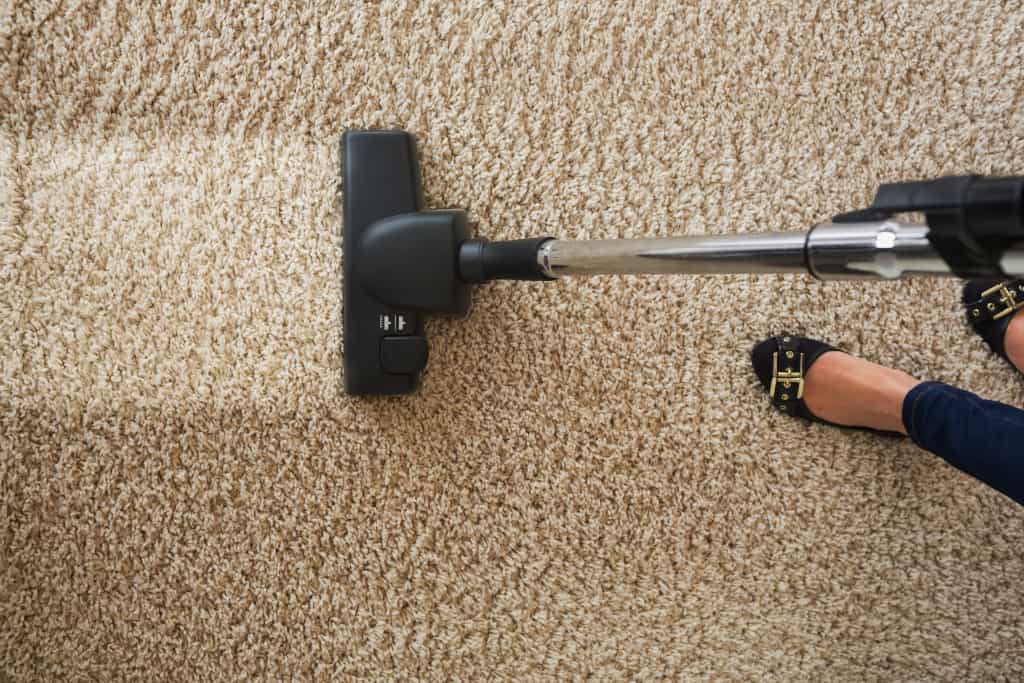
- Keep your house clean. While flea medication or flea pills (oral), topical flea and tick treatment (liquid or gel), and flea collars are the most effective way to prevent an infestation, keeping your house clean is also a big help! So, make sure to vacuum your home frequently, especially if you have carpet. And be sure to hit low-traffic areas of the house as well, such as under furniture and baseboard, as fleas will typically reside in those areas.
- Wash your dog’s bed. Keeping your dog’s bedding clean is equally important. You can soak it in boiling water for five minutes max to kill the flea eggs and larvae. One thing to note, though, don’t leave the bedding in hot water for too long. Or it will cause the filling to melt. Otherwise, you can also wash it with regular laundry detergent, which will be enough to kill any fleas.
- Get rid of fleas in your yard. Another thing you can do is to treat your yard. Use a dog-friendly flea and tick yard spray to break and destroy the flea life cycle before they become a problem for you and your dog.
- Keep stray animals away. Finally, try to keep stray animals away from your house as they are known to carry fleas. One way to do that is to fence up your yard and avoid feeding them. Otherwise, they will keep returning for more food, which will potentially bring unwanted pests to your home.
Frequently Asked Question About the Dog Flea Collar
1. Do flea collars for dogs really work?
Yes, they do. These preventative products are infused with either natural or chemical ingredients designed to repel and kill fleas, and every collar works differently. Some work by releasing gas to repel fleas only, while some will deploy the active ingredients over your dog’s coat and skin to eradicate flea eggs, larvae, and adult fleas.
2. Are flea and tick collars toxic to dogs?
3. How long does it take for flea collars to work?
4. Are flea collars safe for puppies?
5. What are the alternatives to flea collars?

